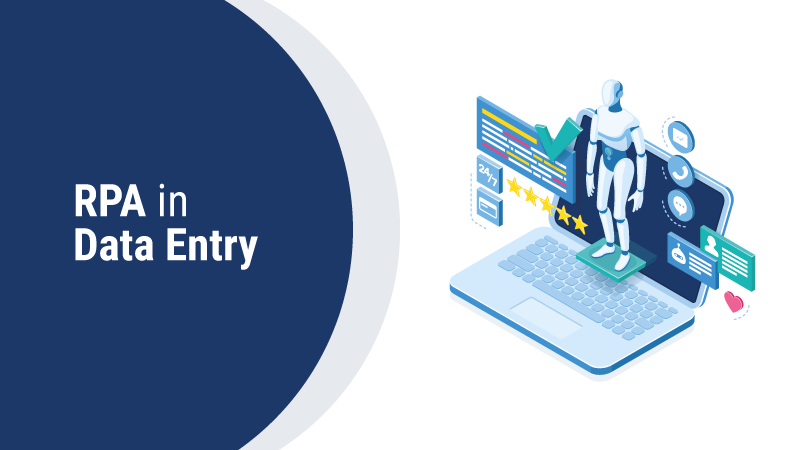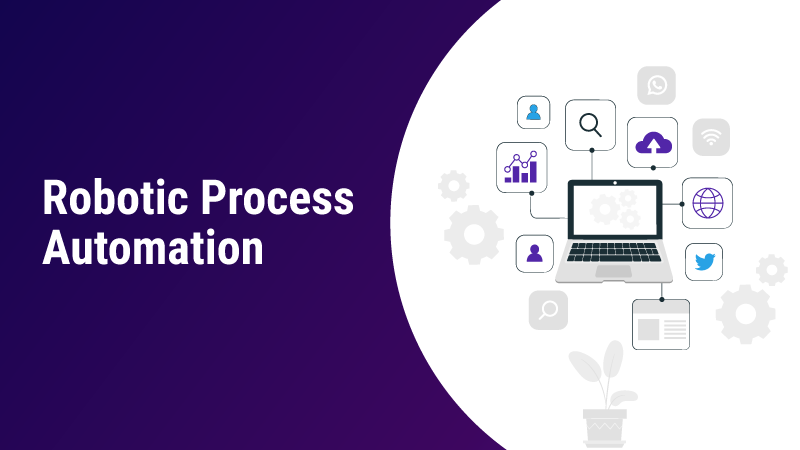Robotic Process Automation in Data Entry

Data entry has always been an important as well as a tedious task performed in almost every business. Initially, data entry was done manually by human employees and it took many hours and days to complete the task. With the advent of Robotic Process Automation (RPA) bots, data entry has become easier and faster. RPA software has lifted the weight of a monotonous task from the shoulders of human workers so that they can focus more on creative and productive work. Deploying data entry bots in any process, where data needs to be entered manually, not only makes the process faster but also results in inaccurate entry of data in less time.
Some of the data entry tasks that we can automate using RPA include:
- Obtaining data from PDF and converting it to word,
- Filling out surveys, questionnaires, and other forms online,
- Payroll data entry,
- Automated file conversion, etc.
Benefits of using RPA for Data Entry
As we have mentioned in the previous paragraph, Robotic Process Automation in data entry is different and easier than the manual process of data entry into the screens through forms. Here are some of the benefits of deploying RPA in data entry.
Quick implementation
Deploying a new RPA solution is very much faster and easier than an employee hiring process. Within days, RPA boys will show their efficiency, once the deployment is completed. Meanwhile, a new human resource needs to go through several stages from getting shortlisted to qualifying for the interviews. After that, they have to go through the training process as well. All these processes can be eliminated by using an efficient RPA solution.
Accurate entry of data
Manual entry of data into systems by human employees is subject to errors that might happen knowingly or unknowingly. This leads to the loss of exact data and can cost a great deal of time and money to companies and businesses. When RPA bots perform the data entry tasks, the data will be more precise and freer of errors than any data entered manually by human workers. RPA bots are designed to perform repetitive tasks without any errors and with the highest level of accuracy. But the important thing to be noted is that the degree of accuracy depends on the optimal character recognition used by the RPA bot.
RPA Enhances Legacy Systems
RPA, being the right technology, enables you to extract data from standard formats to the correct format. The processing server can obtain images, process raw data, and pass the information to the RPA bot. This well-formatted data will be transferred by the bot to your legacy system, even if it requires keystrokes to work. Implementing robotic process automation to receive data through keystrokes enables you to efficiently store processed data. In order to make sure that RPA expands your processed data in the correct fields, engineers can connect the legacy systems with XML code.
Enhanced productivity
The productivity of RPA bots cannot be compared with the efficiency of human employees. RPA boats operate the whole day – which means they can work without rest for 24 hours a day. Meanwhile, a human employee can work only for 40 hours a week. The use of the right tools of RPA allows your business to monitor data-entry processes on auto-pilot. When robotic process automation is implemented properly in businesses, it enables employees to free up their time and resources to focus on tasks that require more productivity and prioritizing. It also gives job satisfaction to the employees.
Scalability
Demand has never been constant, especially with the changing market trends, international crisis, the pandemic, and much more. If there is an unexpected surge or decrease in demand for your product/service (which is very reliable) – hiring employees can become a difficult task. This is where RPA proves its scalability because it gives you the option to add new bots or remove existing ones, depending on the situation. Therefore, automating data-entry processes with RPA bots is simpler and easier than hiring a human employee for the same task.
Eliminate turnover cost
As emotional beings, humans are subjected to change and a variety of factors such as the quality of work, wages, incentives, and work-life balance can motivate us to give up things halfway and go behind other opportunities. Bots are resistant to emotions. They work as they are programmed and never give up on the task they are doing. In simple terms, let’s say that implementing RPA in data entry processes will never make you worry about hiring, onboarding, training employees for different systems, and tracking their performance.
Nominal IT resources
One of the main benefits of implementing RPA is that you do not need to upgrade the existing IT infrastructure to implement RPA. RPA bots take a seat on the other layer, adding new functionalities and features to your legacy systems that are not reconcilable with the new application program interface (APIs). Basically, an RPA implementation partner provides and manages RPA technology. These partners are mainly in charge of the effective working of the software bots like bug fixing, extending repairs, patching updates, and more.
Security
One of the major responsibilities of every business is data security. This is because any data leakage to rivals will have serious repercussions for the development of business in the upcoming future. In particular, for employees with no responsibility or professional ethics, disclosure of confidential data is not at all a serious concern or a matter of loyalty. Many businesses have opted for RPA to restrict the leakage of data considering the fact that RPA bots can neither cheat nor decide which data is important and which is not. This prevents data leakage outside. At the same time, RPA only works on a specific scale, offering maximum protection from external harmful elements.
Wrap Up
Robotics Process Automation (RPA) is revolutionizing the business industry with the many benefits it offers. In this digital era, RPA is a much sought-after area and by 2021 the industry is expected to show a growth of $ 2.9 billion. Those who have already adopted this technology are quickly recouping their investment and reaping the benefits consistently. Implementing RPA to replace manual and inefficient data entry processes facilitates faster and more accurate processing of data.
Get Started with our RPA ServicesBlogs by Category
AppForms Artificial Intelligence Blockchain Call Centers Chatbots Cloud Computing Data Management Design Digital Marketing Digital Transformation Enterprise Applications FinTech Insights LowCode Development Microsoft Mobile Apps News Office 365 Robotic Process Automation Security SharePoint Software Development Web ApplicationWhat is Robotic Process Automation? RPA Explained

2024-05-23 16:56:57